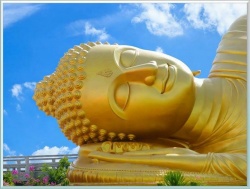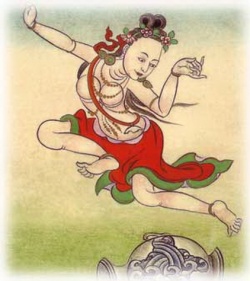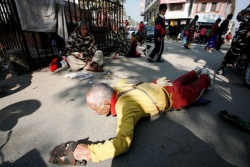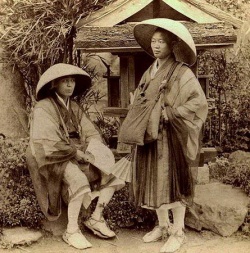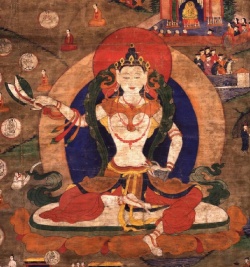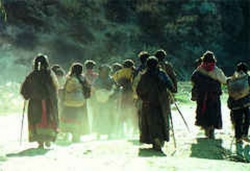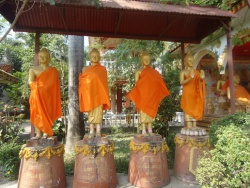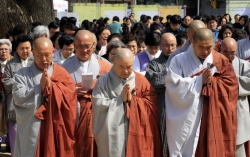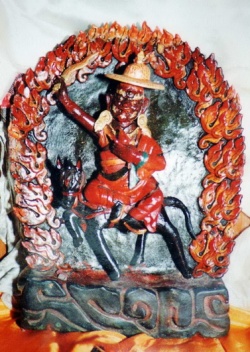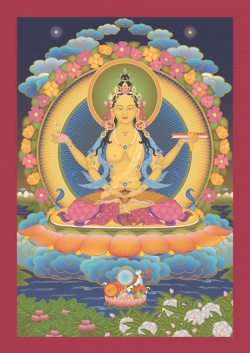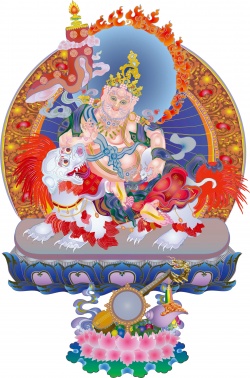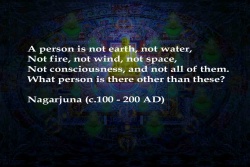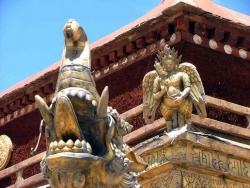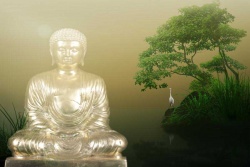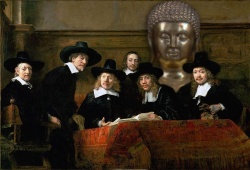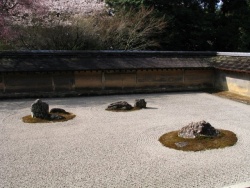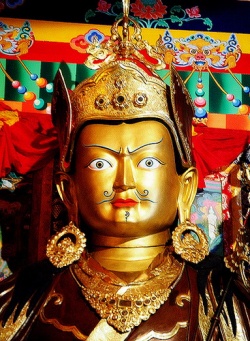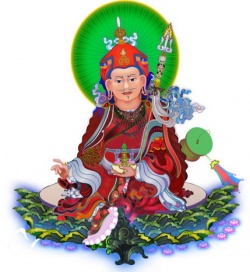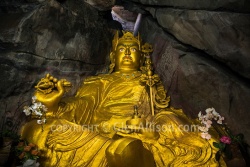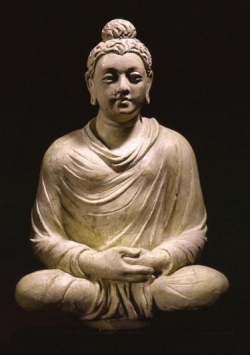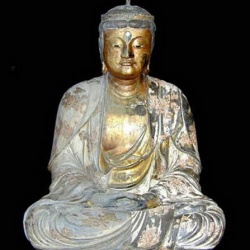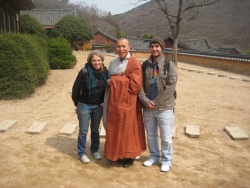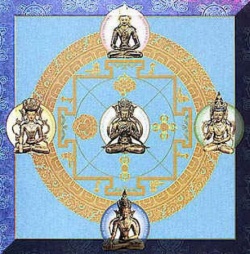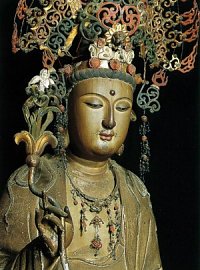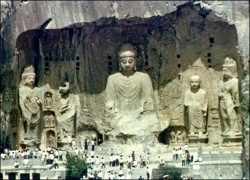Buddhist Wisdom Verses
Buddhist Wisdom Verses
chosen by
The Most Venerable
Rerukane Candavimala Mahanāhimi
(Former Mahānāyaka of the Sri Lankan Svejin Nikāya)
translated by
Ānandajoti Bhikkhu
(first published, February 2011)
Preface
- Sutvā Dhammaṁ vijānanti narā kalyāṇapāpakaṁ,
- After hearing the Dhamma people understand what is good and bad,
- Api gāthā suṇitvāna Dhamme me ramate mano.
- After hearing these verses my mind delights in the Dhamma.
- from the Sutasomajātakaṁ
The following work is based on a book known under its Sinhala title as the Buddha Nīti Saṅgrahaya of Ven. Rerukane Candavimala, the former Mahānāyaka of the Swejin Nikāya in Sri Lanka, which is my ordination sect.
Ven. Rerukane Candavimala, who passed away in 1999 just short of his 100th brithday, was one of the foremost scholars in Sri Lanka in the 20th century, and his works, which cover the whole range of Buddhist studies, including Vinaya, Discourses, Abhidhamma and Meditation, are all still standard works of reference in the country.
Unfortunately his impact has been limited to the Sinhala speaking peoples, as only one of his many works (there are more than 30) has so far been translated into English: Analysis of Perfections (BPS, Kandy 2003), original title (Paramatthaprakaranaya).
I hope the present work, which has been a long-cherished project, will go some way to making his name better known in the English-speaking world, and it is offered as a small tribute to the Venerable Monk's life and work.
- * *
In preparing this volume for publication I have made a number of changes which seemed necessary during the course of my working on the text.
The most obvious of these is the division of the verses into chapters, whereas in the original they were organised into hundreds (sataka). 1 I feel this helps to identify the sections and makes it easier for people to access relevant material also. The chapters are each around 20 verses long, so another advantage is they become easy enough to read and digest a chapter at a time.
I have also added in a short synopsis of the story that forms the basis for the verses, as in many cases it was difficult or even impossible to make sense of the verse without it, especially when there were references to characters in the verses that appeared in the stories; and I have further pointed out the moral of the verses. 2 In a few cases, where I felt that some verses contained matter that is offensive to our modern sensibilities, I have replaced them with verses which I deem to be more appropriate. 3
It has proved necessary to re-establish the texts that were used. I was not intending to do this, but the fact of the matter is the original publication contains many mistakes in the printing, and in checking these it also became clear that there were many readings that could be adopted that would make better sense than the ones the text employed. I therefore eventually checked the text (Text) against the Sinhalese Buddha Jayanti (BJT) edition, the Burmese Chaṭṭha Saṅgāyana (ChS) and the Royal Thai (Thai) editions also.
I have also added in better references than were given in the original, where it would only say something like: Saṁyutta Nikāya; or Dh. Malavagga; or 30 Ni. Mahākapi Jā; and so on. Here I give more exact references: SN 1.1.76 Najīratisuttaṁ; Dhp 246-7 Pañca-Upāsakavatthu (the title coming from the commentary); Jā 516 Mahākapijātakaṁ. I have included some cross-references when they came to my notice, though I would have liked to have been more thorough about this.
I have divided the text into 3 editions so that readers can find the most appropriate one for their reading. The first is in Pāḷi-only, which shows the complete framework for the establishment of the text, including all the metrical information that helped in choosing the readings. I have also read in the text and am making it available as mp3 files, so that students can hear what the text and the metres sound like.
The Text and Translation edition on the other hand leaves out all the metrical information, and presents the text with the Pāḷi and the translation line by line, and gives a translation of the alternative readings, whenever they differed from the adopted text. This is useful for students, who want to gain access to the original language, but for whom a translation is still a necessary help.
The English edition is for those who simply want to read and understand the teachings that are contained in the verses, or are seeking advice on the best way of living their everyday lives.
I have included the Pāḷi in this edition, but I have deliberately avoided annotation here so that the message can be better conveyed, and also because this section is being published as audio .mp3 files, where annotation is superfluous. This edition is also available in .epub and .mobi formats for your eReader.
I have complemented the various editions by adding in various hyperlinked indexes that help access the material, and that are contained in the most relevant edition. There are also separate introductions to the different versions, giving extra and relevant information.
Ānandajoti Bhikkhu
February 2011
Introduction to the Text and Translation Edition
This collection of verses, made by one of the leading scholar-monks in Sri Lanka in the 20th century, is one of the most useful compiliatons on the moral life of the layman that can be found.
Drawn mainly from the great verses collections in the Pāḷi Nikāyas 1 almost all aspects of the lay life have been covered, and it brings together in a fairly comprehensive way many teachings that would otherwise be lost in obscurity.
Throughout the book it is possible to find teachings on all matters of the ethical life, that will help guide anyone to make better life-choices whether it be at business and work, or in the home life and their various relationships.
Around two-thirds of the verses are drawn from the Jātaka stories, and it was this great storehouse of wisdom stories that formed the ethical thinking of most of the Buddhist societies in the Middle Ages, but which now has gone out of fashion.
The great heroes of those days, in such strong contrast to the present day, were the Bodhisatta, the penitant hermits in the woods, the great Kings who ruled justly, and the clever and mischievous animals who had a moral to illustrate, and who all came alive on the greater canvas of the moral universe.
These days, of course, things appear to be much more confusing. They are, in the sense that the lines between right and wrong can often be very grey, and actions may seem remote from results; they are not, when ethical principles are clearly understood and applied. 0 The teachings herein cover how to live in the right way and avoid the wrong way; how to honestly gain one's wealth and use it fruitfully; how to choose one's friends and be wary of the treacherous; what are helpful and harmful modes of speech; how to judge the character of others; and many other topics, that are all dealt with in a memorable and succint way.
This is also a book that can be returned to time and again to remind oneself of the teachings, and in that sense each of the stories is a meditative reflection. In its present form it also acts as an easy source book for some of the many teachings there are for the lay community in the Canon, and can be utilised to find guidance when in doubt.
There are altogether 251 sections to the book, and each story has anywhere between one and eleven verses 2 attached to it. Sometimes we also find that different verses have been drawn from the same source, but separately, so as to illustrate different moral points. 3
In this Text and Translation edition I have given a fairly literal translation of the text, so that the student should be able to begin to understand the Pāḷi which is printed along with it, 4 and indeed the main purpose of this edition is to enable a better understanding of the Pāḷi verses themselves.
I have also given the variant readings when the meaning differs significantly from the reading in the text, 5 although these variations are interesting they are generally quite minor, and only occasionally include things like the omission of a negative, which thereby reverses the meaning of the text.
I have translated passages from the various commentaries when the meaning of a passage seemed to me to be in doubt or in need of explanation, and have included comments of the grammar of the verses where this seemed necessary, and other explanatory material needed for a better comprehension of the text.
Ānandajoti Bhikkhu
February 2011
1: Sīlavaggo
Virtue
Jā 406 Gandhārajātakaṁ
The Gandhāra Realm
- One should be Amenable to Admonition
Two Kings renounced the world and lived as ascetics. One day they fell into a quarrel about who should admonish the other.
1. No ce assa sakā buddhi, vinayo vā susikkhito,[1]
If he himself is not well-trained, intelligent and disciplined,
Vane andhamahiṁso va careyya bahuko jano.
Many a person will wander in the wood like a buffalo that is blind.
2. Yasmā ca panidhekacce ācāramhi [2] susikkhitā,
But since there are some who aspire to be well-trained in good conduct,
Tasmā vinītavinayā [3] caranti susamāhitā.
Therefore, trained in the discipline, [4] they live (with their minds) well-composed.
DN 14 Mahāpadānasuttaṁ [5]
The Great Legend
- True Cultivation
This verse is a well-known summary of the teaching, given by all the Buddhas. In some of the Dispensations it replaced the more detailed teaching found in the Rules of Discipline (Vinaya).
3. Sabbapāpassa akaraṇaṁ, kusalassa upasampadā,
Not doing anything wicked, the undertaking of what is good,
Sacittapariyodapanaṁ – etaṁ Buddhāna' Sāsanaṁ.
And the purification of one's mind – this is the Teaching of the Buddhas.
Jā 84 Atthassadvārajātakaṁ
The Gateways to Benefit
- The Six Gateways to Benefit
A son asked his Father (the Bodhisatta) for advice on the spiritual life. The Father explained these six gateways leading to great benef it in life.
4. Ārogyam-icche, paramañ-ca lābhaṁ,
Desire (the following): (good) health, [6] the greatest gain,
Sīlañ-ca vuddhānumataṁ [7] sutañ-ca,
Virtue, approval by elders and learning,
Dhammānuvattī ca alīnatā ca:
Conformity to the Dhamma, striving:
Atthassa dvārā pamukhā chaḷete.
These six gateways are of the foremost benefit.
AN 8.54 Dīghajāṇusuttaṁ
Long-Knee the Householder
- Eight things Leading to Prosperity
A householder asks the Buddha for advice on how to live well in his present state.
5. Uṭṭhātā kammadheyyesu, appamatto vidhānavā,
Being active in the realm of (good) deeds, being heedful and circumspect,
Samaṁ kappeti jīvikaṁ sambhataṁ anurakkhati,
Equanimous in making his living and protecting his savings,
6. Saddho sīlena sampanno, vadaññū vītamaccharo,
Endowed with faith and virtue, being bountiful, unselfish,
Niccaṁ maggaṁ visodheti, sotthānaṁ samparāyikaṁ,
Always purifying the path, heading for safety in the next world,
7. Iccete aṭṭhadhammā ca saddhassa gharam-esino,
For the faithful householder having these eight things,
Akkhātā Saccanāmena, ubhayattha sukhāvahā.
(This) was declared by the one named Truth, [8] as leading to happiness in both places. [9]
DN 31 Sigālasuttaṁ
Advice to Sigāla
- Four Ways to spend one's Wealth
The Buddha gives instructions to the young man Sigāla on the four kinds of friends, and then tells him how to keep them.
8. Paṇḍito sīlasampanno jalam-aggīva bhāsati,
The Wise One endowed with virtue shines like a burning fire,
Bhoge saṁharamānassa, bhamarasseva iriyato
He is one who is gathering wealth, just like the bees move and
Bhogā sannicayaṁ yanti, vammiko vupacīyati.
Strive to pile up their wealth, (or like) an ant-hill is piled-up.
9. Evaṁ bhoge samāhatvā, alam-atto kule gihī,
Having gathered wealth like this, enough for his family and home,
Catudhā vibhaje bhoge, sa ve mittāni ganthati:
He can divide his wealth in four ways, which will bind his friends:
10. Ekena bhoge bhuñjeyya, dvīhi kammaṁ payojaye,
With one part he should enjoy his wealth, with two parts he should manage his work,
Catutthañ-ca nidhāpeyya, āpadāsu bhavissati.
The fourth he should deposit, to be used against misfortune.
AN 5.58 Licchavikumārakasuttaṁ
The Young Licchavis
- A Wise Man's Duties
The Buddha explains the five duties which, when fulfilled, lead to prosperity and not to decline.
11. Mātāpitukiccakaro, puttadārahito sadā,
Doing his duty to Mother and Father, and always benefitting his children and wife,
Anto janassa atthāya, yo cassa upajīvino.
For the welfare of the one in his home, and for those who live in dependence,
12. Ubhinnaṁ yeva atthāya, vadaññū hoti sīlavā,
For the welfare 10 of both, the virtuous one is bountiful,
Ñātīnaṁ pubbapetānaṁ, diṭṭhadhamme ca jīvitaṁ.
For the relatives who have departed, and those who live in this very life.
13. Samaṇānaṁ brāhmaṇānaṁ, devatānañ-ca Paṇḍito
For the ascetics, brāhmaṇas and the gods, the Wise One
Vittisañjanano hoti, Dhammena gharam-āvasaṁ.
Is one who generates joy, being a householder (endowed) with the Dhamma. [10]
14. So karitvāna kalyāṇaṁ, pujjo hoti pasaṁsiyo,
Having done what is good, he is worshipful and praiseworthy,
Idheva naṁ pasaṁsanti, pecca Sagge pamodati.
They praise him right here (and now), and after passing away he rejoices in heaven.
AN 4.61 Pattakammasuttaṁ
Suitable Deeds
- The Right Uses of Wealth
The Householder Anāthapiṇḍika receives instruction on the right ways to make use of the wealth that has been righteously obtained.
15. Bhuttā bhogā bhatā [11] bhaccā, vitiṇṇā āpadāsu me,
Wealth enjoyed by servants and brothers, or for overcoming misfortunes by me,
Uddhaggā dakkhiṇā dinnā, atho pañcabalīkatā,
Given in lofty donations, also through making the five offerings, [12]
Upaṭṭhitā sīlavanto, saññatā brahmacārayo.
Has been established by the virtuous, skilful ones who live spiritually.
16. Yad-atthaṁ bhogaṁ iccheyya Paṇḍito Gharam-āvasaṁ:
The Wise Householder can wish for wealth and welfare (thinking):
‘So me attho anuppatto kataṁ ananutāpiyaṁ.’
‘That prosperity attained by me is a cause of lack of remorse.’
17. Etaṁ anussaraṁ macco, Ariyadhamme ṭhito naro,
A mortal remembering this, a person who is established in Nobility, [13]
Idheva naṁ pasaṁsanti, pecca Sagge pamodati.
They praise him right here (and now), and after passing away he rejoices in heaven.
DN 31 Sigālasuttaṁ
Advice to Sigāla
- The Wise attain Fame
These are the Buddha's words at the conclusion of the instruction given to the young man Sigāla.
18. Paṇḍito sīlasampanno, saṇho ca paṭibhānavā,
The Wise One endowed with virtue, gentle and of ready wit,
Nivātavutti atthaddho: tādiso labhate yasaṁ.
Humble and not haughty: such a one will (rightly) gain fame.
19. Uṭṭhānako analaso, āpadāsu na vedhati,
Active, not lazy, not trembling in misfortune,
Acchinnavutti medhāvī: tādiso labhate yasaṁ.
Without defects and intelligent: such a one will (rightly) gain fame.
20. Saṅgāhako mittakaro, vadaññū vītamaccharo,
Kindly and a maker of friends, bountiful, unselfish,
Netā vinetā anunetā: tādiso labhate yasaṁ.
A guide, a leader, a conciliator: such a one will (rightly) gain fame.
21. Dānañ-ca peyyavajjañ-ca, atthacariyā ca yā idha,
Generous, with lovely speech, one who lives benefically here,
Samānatā ca dhammesu, tattha tattha yathārahaṁ,
Equanimous towards all things, he does that which is suitable in all places,
Ete kho saṅgahā loko [14] rathassāṇī va yāyato.
These kindnesses, like a chariot's linchpin, make the world go round.
22. Ete ca saṅgahā nāssu, na Mātā puttakāraṇā
* Without these kindnesses, Mothers would not receive the duties due from their children
Labhetha mānaṁ pūjaṁ vā, Pitā vā puttakāraṇā.
(Such as) respect and honour, Fathers would not receive them too.
23. Yasmā ca saṅgahe ete samavekkhanti Paṇḍitā.
Wherefore the Wise have consideration for these kindnesses,
Tasmā mahattaṁ papponti, pāsaṁsā ca bhavanti te.
Therefore they attain greatness, and they are ones who are praised.
DN 31 Sigālasuttaṁ
Advice to Sigāla
- Four Things not to be Done
The teaching to Sigāla on what increases and decreases fame and good fortune.
24. Chandā dosā bhayā mohā, yo Dhammaṁ ativattati,
For one who trangresses the Dhamma through desire, hate, fear, delusion,
Nihīyati tassa yaso, kāḷapakkhe va candimā.
His fame diminishes, like the moon in the dark fortnight. [15]
25. Chandā dosā bhayā mohā, yo Dhammaṁ nātivattati,
For one who doesn't trangress the Dhamma through desire, hate, fear, delusion,
Āpūrati tassa yaso, sukkapakkhe va candimā.
His renown increases, like the moon in the bright fortnight.
Footnotes
- ↑ Text: na vijjati; are not found.
- ↑ Text, ChS, Thai: Āceramhi; locative with instrumental sense, by the Teacher?
- ↑ Text, Thai: Vinītaviniyā Dhīrā; The Wise, well-led; making the metre hypermetric by two syllables.
- ↑ Comm: vinayena vinītattā vinītavinayā.
- ↑ This verse also appears in Dhammapada, vs. 183 Buddhavaggo.
- ↑ Both physical and mental, the commentary explains.
- ↑ Thai: Buddhānumataṁ; approval by the Buddha.
- ↑ I.e. the Buddha.
- ↑ I.e. in this world and in the next.
- ↑ This is the so-called Instrumental of Attendant Circumstance (Syntax, §65), but it would be better to refer to it as the Adjectival Instrumental, as it is qualifying the person. It is a very common usage.
- ↑ Thai: bhaṭā; this maybe the same word, with an alternative spelling, PED doesn't list it; [Wealth enjoyed] by hirelings.
- ↑ I.e. offerings to relatives (ñāti), guests (atithi), departed (pubbapeta), kings (rāja) and the gods (devatā).
- ↑ Comm: pañcasīladhamme patiṭṭhito; established in the five virtuous practices.
- ↑ ChS: loke; [make] the worlds [go round].
- ↑ The dark fortnight is the time when the moon is waning; the bright fortnight (below) when it is waxing.




